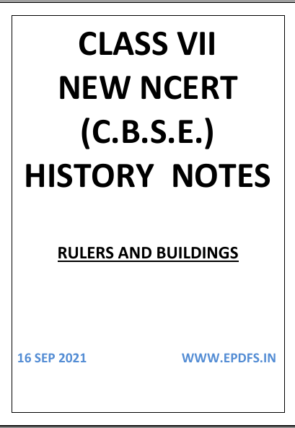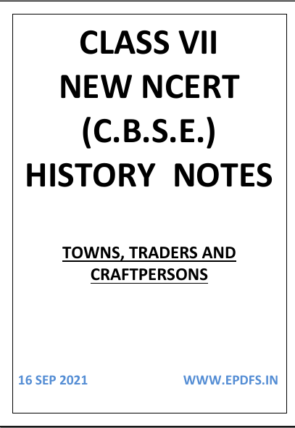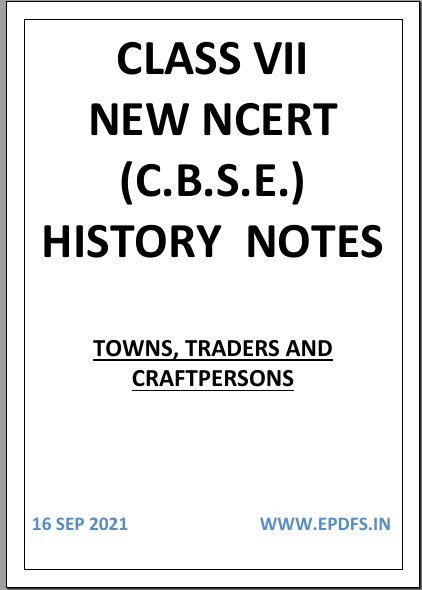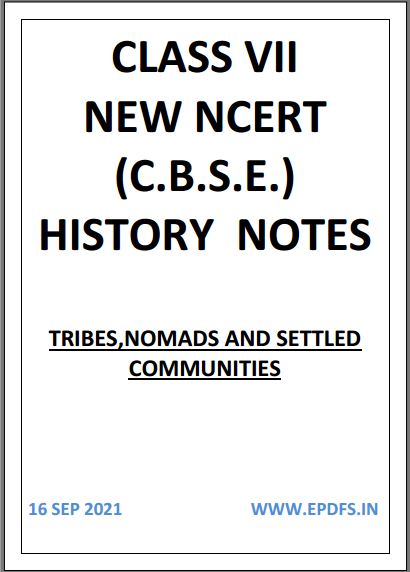Showing 17–19 of 19 results

CLASS 7 HISTORY CHAPTER-RULERS AND BUILDINGS FREE PDF NOTES

RULERS AND BUILDINGS FREE PDF NOTES GENERAL BRIEF :-
The Mughal Empire Free PDF notes have been made from Class VII Latest History NCERT book. In addition to the content that is been provided by author in the respective book, no additional content has been added in order to make the notes more attractive.
TO WHOM ARE RULERS AND BUILDINGS FREE PDF NOTES USEFUL ?
The Delhi Sultan free PDF Notes are helpful to the following students :-
- Those Students who have already gone through their syllabus thoroughly and just looking after the short content to give it a final glance at the time of revision.
- Those Students who don’t want to study the whole NCERT books thoroughly in detail.
- Those Students who are looking after the short notes of NCERT History book classwise and chapterwise.
- Those students who want to give a final touch to NCERT books while preparing for competitive Examination.
WHAT DID RULERS AND BUILDINGS FREE PDF NOTES CONTAINS ?
- NCERT content’s short notes.
- NCERT content’s DID YOU KNOW.
- Definition from this Chapter.
- Very Important Points from this Chapter.
Temples and Mosques were the places to worship. Temple was also used as a means to demonstrate power and wealth. Rulers used to build the huge temple which depicts the picture of the world they ruled. These temples also included deities of the subordinate.
Islam does not have the belief in incarnations of god but they built beautiful architecture known as mosques to offer there pray to God.
Rulers in the era of politics used religious architecture to gain fame. They build reservoirs and cultural center. They got involved in building well which was there for common people and ultimately was known for their great deeds.
Have you ever visited the Taj Mahal? Stunning isn’t it? But did you know that the Taj Mahal is actually a mosque? In fact, a lot of the important national monuments that were built by rulers of ancient times are actually forts, palaces etc. Let us take a look at the architecture of some important monuments built by rulers.
Only registered users can download this book.
Please Login/Register first.

CLASS 7 HISTORY CHAPTER-TOWNS,TRADERS AND CRAFTPERSONS FREE PDF NOTES

TOWNS,TRADERS AND CRAFTPERSONS FREE PDF NOTES GENERAL BRIEF :-
Towns,Traders an d Craftpersons Free PDF notes have been made from Class VII Latest History NCERT book. In addition to the content that is been provided by author in the respective book, no additional content has been added in order to make the notes more attractive.
TO WHOM ARE TOWNS,TRADERS AND CRAFTPERSONS FREE PDF NOTES USEFUL ?
Towns,Traders and Craftpersons free PDF Notes are helpful to the following students :-
- Those Students who have already gone through their syllabus thoroughly and just looking after the short content to give it a final glance at the time of revision.
- Those Students who don’t want to study the whole NCERT books thoroughly in detail.
- Those Students who are looking after the short notes of NCERT History book classwise and chapterwise.
- Those students who want to give a final touch to NCERT books while preparing for competitive Examination.
WHAT DID TOWNS,TRADERS AND CRAFTPERSONS FREE PDF NOTES CONTAINS ?
- NCERT content’s short notes.
- NCERT content’s DID YOU KNOW.
- Definition from this Chapter.
- Very Important Points from this Chapter.
Several small towns came to be seen in the sub-continent from the 8th century onward. These towns usually had a mandapika or mandi where nearby villagers came to sell their produce. These towns also had market streets called halta or hoot lined with shops.
Hampi was a well-fortified city. No mortar or cementing agent was used in the construction of these walls. The technique followed was to wedge them together by inter-locking.Hampi was the capital of the Vijayanagara Empire in the 14th century.
Chronicles left by Persian and European travellers, particularly the Portuguese, say that Hampi was a prosperous, wealthy and grand city near the Tungabhadra River, with numerous temples, farms and trading markets.
By 1500 CE, Hampi-Vijayanagara was the world’s second-largest medieval-era city after Beijing, and probably India’s richest at that time, attracting traders from Persia and Portugal. The Vijayanagara Empire was defeated by a coalition of Muslim sultanates; its capital was conquered, pillaged and destroyed by sultanate armies in 1565
Only registered users can download this book.
Please Login/Register first.

CLASS 7 HISTORY CHAPTER-TRIBES,NOMADS AND SETTLED COMMUNITIES FREE PDF NOTES

TRIBES,NOMADS AND SETTLED COMMUNITIES FREE PDF NOTES GENERAL BRIEF :-
Tribes,Nomads and Settled Communities Free PDF notes have been made from Class VII Latest History NCERT book. In addition to the content that is been provided by author in the respective book, no additional content has been added in order to make the notes more attractive.
TO WHOM ARE TOWNS,TRADERS AND SETTLED COMMUNITIES FREE PDF NOTES USEFUL ?
Tribes,Nomads and Settled Communities free PDF Notes are helpful to the following students :-
- Those Students who have already gone through their syllabus thoroughly and just looking after the short content to give it a final glance at the time of revision.
- Those Students who don’t want to study the whole NCERT books thoroughly in detail.
- Those Students who are looking after the short notes of NCERT History book classwise and chapterwise.
- Those students who want to give a final touch to NCERT books while preparing for competitive Examination.
WHAT DID TRIBES,NOMADS AND SETTLED COMMUNITIES FREE PDF NOTES CONTAINS ?
- NCERT content’s short notes.
- NCERT content’s DID YOU KNOW.
- Definition from this Chapter.
- Very Important Points from this Chapter.
Several small towns came to be seen in the sub-continent from the 8th century onward. These towns usually had a mandapika or mandi where nearby villagers came to sell their produce. These towns also had market streets called halta or hoot lined with shops.
Hampi was a well-fortified city. No mortar or cementing agent was used in the construction of these walls. The technique followed was to wedge them together by inter-locking.Hampi was the capital of the Vijayanagara Empire in the 14th century.
Chronicles left by Persian and European travellers, particularly the Portuguese, say that Hampi was a prosperous, wealthy and grand city near the Tungabhadra River, with numerous temples, farms and trading markets.
By 1500 CE, Hampi-Vijayanagara was the world’s second-largest medieval-era city after Beijing, and probably India’s richest at that time, attracting traders from Persia and Portugal. The Vijayanagara Empire was defeated by a coalition of Muslim sultanates; its capital was conquered, pillaged and destroyed by sultanate armies in 1565
Only registered users can download this book.
Please Login/Register first.